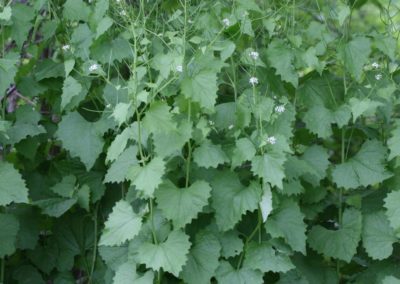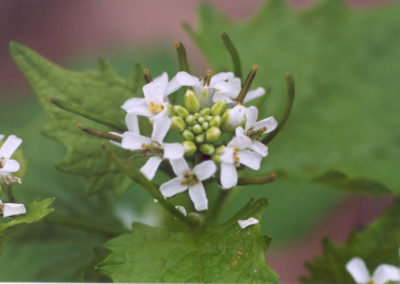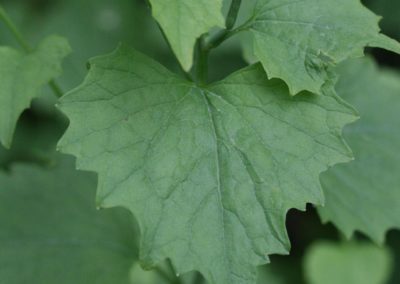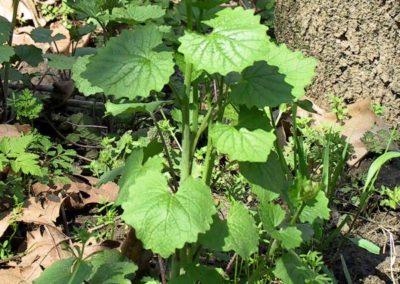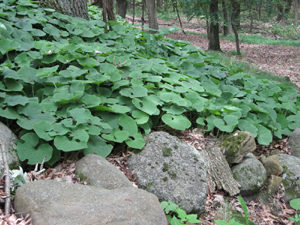Garlic Mustard (Alliaria petiolata)
Invasive Management Profile
Garlic Mustard is an invasive plant from Europe that thrives in woodlands and negatively impacts forest habitats.
Identification
Garlic Mustard is fairly easy to identify due to its leaf shape, flowers, and garlic smell. The young leaves are usually in clusters of 3-8 leaves, are kidney-shaped with scalloped edges, and have a wrinkled appearance. Garlic Mustard leaves will remain green all winter. As the plant ages, the older leaves will be heart-shaped or more triangular and about 1-3 inches wide. The edges will still be toothed or scalloped. Its flowers are small (1/4 inch) with 4 white petals on the end of the main stem and side branches. The Garlic Mustard flowers bloom April through June. A Garlic Mustard stalk will typically grow to 1-4 feet tall. A helpful tip when identifying Garlic Mustard is that the plant’s leaves give off a garlic odor when crushed.
Tools & Supplies Needed
- Shovel, spade, or lopper
- Protective eyewear, gloves, and clothing
- Paper or plastic bags for disposal
Removal Methods
Garlic Mustard is fairly easy to eradicate but can continue to sprout for 2-5 years based on the seed development and spreading, so make sure to check the area for regrowth. In smaller, more confined areas use the hand pulling method.
STEP 1 : Identify plant using our identification tips and photos as well as the time of year and growth stage.
STEP 2 : Wear protective eyewear, gloves, and clothing.
STEP 3 : Use your hand to grab the bottom of the plant, twist, and pull.
STEP 4 : When pulling, make sure to remove the taproot, which is the main root system (this may be easily removed with a spade or shovel as well).
STEP 5 : Make sure to place all plant debris into a plastic or paper bag to control seed spread.
STEP 1 : Identify plant using our identification tips and photos as well as the time of year and growth stage.
STEP 2 : Wear protective eyewear, gloves and clothing.
STEP 3 : Use clippers or gardening scissors to cut the plant half of an inch from the ground.
STEP 4 : After cutting, use a spade or shovel to dig out the root system.
STEP 5 : Make sure to place all plant debris into a plastic or paper bag to control seed spread.
Disposal
When pulling and cutting Garlic Mustard before budding, immediate baggage is not necessary. But after the plant has started to bud, it must be bagged immediately. Pull the plant and place in a large plastic or paper bag. The pulled plant can also be dried out and burned for disposal.
To prevent regrowth of Garlic Mustard, make sure to wash all shoes and clothing after working with the plant. Garlic Mustard seeds are small enough to be carried to other areas on clothing and shoes. Remember to monitor your yard for regrowth.
Native Alternative Species
To learn more about natives and how to landscape with them here.
Wild Ginger (Asarum canadense)
|
Growth Type: Herbaceous Perennial Height: 1/2 to 1 Spread: 1 to 1 1/2 feet Bloom Time: April-May; purplish brown Light exposure: Part to Tolerates: Heavy Shade |
Photo Courtesy of INPAWS |

